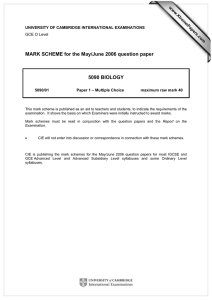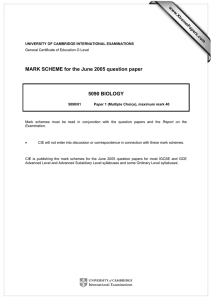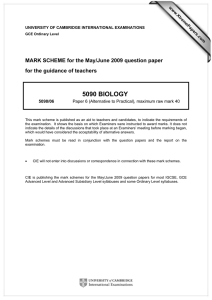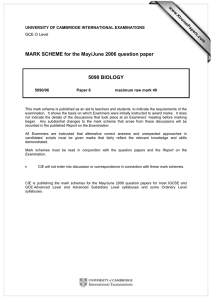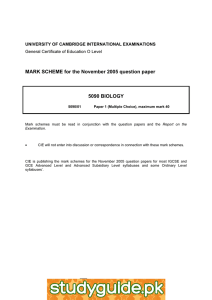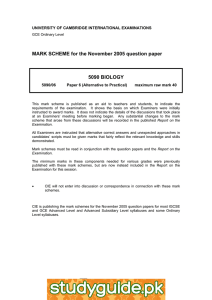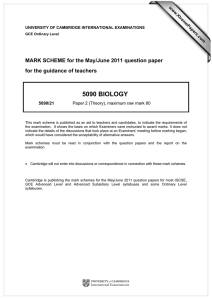5090 BIOLOGY MARK SCHEME for the May/June 2012 question paper
advertisement
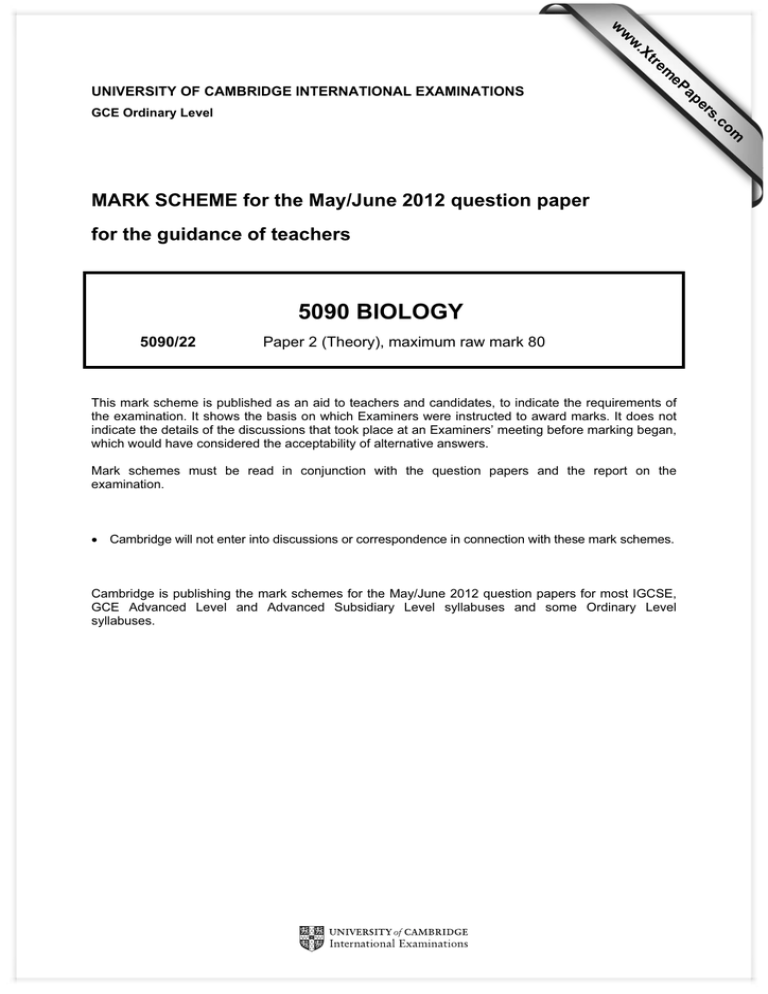
w w ap eP m e tr .X w UNIVERSITY OF CAMBRIDGE INTERNATIONAL EXAMINATIONS s er om .c GCE Ordinary Level MARK SCHEME for the May/June 2012 question paper for the guidance of teachers 5090 BIOLOGY 5090/22 Paper 2 (Theory), maximum raw mark 80 This mark scheme is published as an aid to teachers and candidates, to indicate the requirements of the examination. It shows the basis on which Examiners were instructed to award marks. It does not indicate the details of the discussions that took place at an Examiners’ meeting before marking began, which would have considered the acceptability of alternative answers. Mark schemes must be read in conjunction with the question papers and the report on the examination. • Cambridge will not enter into discussions or correspondence in connection with these mark schemes. Cambridge is publishing the mark schemes for the May/June 2012 question papers for most IGCSE, GCE Advanced Level and Advanced Subsidiary Level syllabuses and some Ordinary Level syllabuses. Page 2 Mark Scheme: Teachers’ version GCE O LEVEL – May/June 2012 Syllabus 5090 Abbreviations Mark schemes will use these abbreviations: ; / R A AW max + separates marking points alternatives reject accept alternative wording underline actual word given must be used the maximum number of marks that can be given statements on both sides of the + are needed © University of Cambridge International Examinations 2012 Paper 22 Page 3 Mark Scheme: Teachers’ version GCE O LEVEL – May/June 2012 Syllabus 5090 Paper 22 Section A 1 (a) (i) A B pupil / aqueous humour / anterior chamber; cornea; [2] (ii) dilates / gets big / enlarges / opens / gets wide / expands; [1] (iii) Z on ciliary muscle / iris / external muscle; [1] (b) reasonable ref. light receptors / sensitive cells / rods / cones; not in contact with optic nerve; no impulses; to brain; no picture formed / unable to see / blindness; (R blurred vision or reduced visionary powers) less / no nutrition for retina; [max. 3] (c) failure to focus (all) light (rays); blurred image AW; any reference to the passage of light rays being impaired (e.g. reflection / refraction / deflection / absorption / convergence); ref. possible change in elasticity / ability to accommodate; faded colour vision; 2 [max. 3] (a) (i) Mark as follows: Award 2 marks for a correct answer with no working;; Award 3 marks for a correct answer with any working;;; Award 2 marks max. for correct working with no or wrong answer;; Answer: 4.7(6)(%) (A 4.7 / 4.8);; Examples of correct working are as shown below : 1600 25 / OR 1600 × / OR 400 (;) 4 100 400 (;) 8400 [3] (ii) higher (R ref. to higher GDA); © University of Cambridge International Examinations 2012 [1] Page 4 Mark Scheme: Teachers’ version GCE O LEVEL – May/June 2012 Syllabus 5090 Paper 22 (b) more or a high amount AW fibre / roughage; [1] (c) (i) bones; soft / weak / deformed / bent / ref. bandy legs ; (R bent ‘legs’ – that is the effect of the knee joint.) (Mark the first effect in a list) [2] (ii) C; vitamin D / uptake of calcium / calcium used by bones AW; 3 [max. 2] (a) (i) cell wall + correct drawing (outside existing line); (ii) nucleus + correct drawing (must be in cytoplasm); (iii) vacuole / cytoplasm + correct drawing (if vacuole, must be larger than the nucleus.); [3] If no marks scored through unacceptable drawings, allow max. 1 if all 3 are shown in the correct positions – vacuole in the middle, cell wall on the outside and nucleus between. (b) elongation of cell (R cylindrical); loss of cell contents / or one named content (A ref. death of cell / hollow) (R chloroplasts / dissolving of cell contents.); loss of end walls; addition of thickening / strengthening material / lignin; [max. 3] (c) (stem) contains xylem; (xylem is) thickened / strengthened / contains lignin; provides support; (leaf) xylem less important for support; loss of water / transpiration; water not replaced / doesn’t reach leaves; cells become flaccid / lose turgor AW (R plasmolysed); cells unable to support weight of leaf / wilts; © University of Cambridge International Examinations 2012 [max. 5] Page 5 4 Mark Scheme: Teachers’ version GCE O LEVEL – May/June 2012 Syllabus 5090 Paper 22 (a) animal dispersal (A plausible named animal); attraction + colour / succulence / smell; (fruit) eaten / ref. food; time for digestive processes AW; seeds are not digested; pass out with faeces / egested AW; ref. seeds discarded elsewhere; [max. 5] (b) (i) ref. to interference with the sexual reproductive process / infertility; meiosis / reduction division not possible; gamete formation / seed production impaired AW; [max. 1] (ii) (A reverse argument re. diploid animals) many plants can reproduce asexually / propagate vegetatively; mitosis unaffected / meiosis not involved; triploids more hardy / survive better AW; [max. 2] (c) chromosomes; mutation / ref. to meiosis AW ; gamete + one extra / 24 (chromosomes); one extra (chromosome) / 47 + inherited / handed on; (mark not awarded for saying offspring have 47 chromosomes) 5 (a) (i) 37–39 °C (A range or any temperature within the range); [max. 3] [1] (ii) (If first line blank, then Max. 1 for location if correct for function) A any human enzyme or enzyme from biotechnology ; location (specific rather than general) correct for enzyme; function correct for named enzyme (substrate + product); © University of Cambridge International Examinations 2012 [3] Page 6 Mark Scheme: Teachers’ version GCE O LEVEL – May/June 2012 Syllabus 5090 Paper 22 (b) denatured / destroyed; stops working / no product made / cannot be used again; relevant ref. active site; substrate no longer fits / no formation enzyme-substrate complex AW; correct use of lock and key idea; possible effect of heat on shape of substrate molecule; [max. 5] [Total: 50] © University of Cambridge International Examinations 2012 Page 7 Mark Scheme: Teachers’ version GCE O LEVEL – May/June 2012 Syllabus 5090 Paper 22 Section B 6 (a) testa / seed coat + protection (any qualification must be plausible); testa / testa + water entry / gas or named gas passage; endosperm / cotyledons / seed leaves + food storage; cotyledons / seed leaves + first (green) leaves; cotyledons / seed leaves + eventually used for photosynthesis; embryo + forms (new) plant; radicle + (young) root; plumule + (young) shoot / stem; micropyle + water entry; micropyle + gas or O2 entry / CO2 exit; [max. 7] (b) water uptake + a function (e.g. dissolution); oxygen uptake + respiration / for energy release; any named e.g. of energy use (cell division / active transport); ref. mitosis / cell division + growth; enzyme action + why it is needed; 7 [max. 3] (a) (Marking points are available on an annotated drawing) shows the number of organisms at each (trophic) or named level ; (R species) width / length of band indicates the number; number of organisms decreases towards the top of the pyramid; correct ref. to two technical terms from the following : producers / consumers / herbivores / carnivores / trophic level; (R named example) in food chain / web / ecosystem (R habitat / named e.g. of a food web); ref. to an anomalous situation (e.g. trees / single tree); © University of Cambridge International Examinations 2012 [max. 4] Page 8 Mark Scheme: Teachers’ version GCE O LEVEL – May/June 2012 Syllabus 5090 Paper 22 (b) ref. Sun; light (energy) to chemical energy; absorbed by / inside plants or producers / photosynthesis; named photosynthetic product; food for / eaten by + animals / herbivores / consumers / decomposers; lost as heat; (from) respiration / ref ATP; any *two uses of energy (for two marks);; *Any two from: active transport, muscle contraction / movement / locomotion, e.g. of anabolism / protein synthesis / making large molecules, temperature control, nervous impulses, growth, cell division / mitosis / meiosis does not pass back to producers / plants / Sun; 8 [max. 6] (a) (i) (osmosis) ref. diffusion; of water ; from high to low (water) molecular concentration or water potential / low to high solute concentration.; Ref. to partially permeable membrane AW; passive / no energy required ; e.g. of an application; [max. 4] (ii) (active transport) movement of ions / molecules / substances; against a concentration gradient; needs living or cell membrane; energy required; from respiration; e.g. of an application; © University of Cambridge International Examinations 2012 [max. 4] Page 9 Mark Scheme: Teachers’ version GCE O LEVEL – May/June 2012 Syllabus 5090 Paper 22 (b) thin walls / one cell thick + alveoli / air sacs / capillaries; haemoglobin + oxygen absorption; ref. relatively high concentration of oxygen in the lungs / oxygen regularly replenished / more oxygen in the air than in the blood; continuous movement of blood; large surface area / alveoli have rich supply / surrounded by capillaries; 9 [max. 2] (a) toxic / poisonous materials (R harmful); waste products + metabolism AW; (R refs. to salts) urea; liver / blood + kidneys; urine; urethra; sweat; skin / (epi)dermis; carbon dioxide; from cells / blood + alveoli; exhaled / breathed out / expelled or removed from lungs AW; [max. 8] (b) undigested food; cellulose / fibre / lignin / roughage; not from metabolism AW; © University of Cambridge International Examinations 2012 [max. 2]
